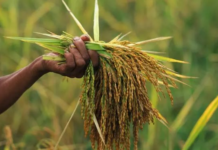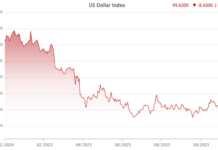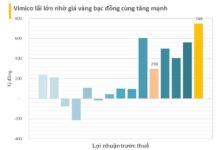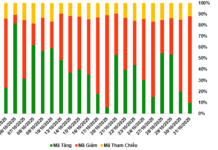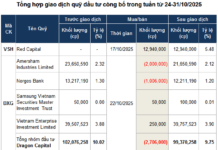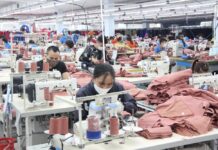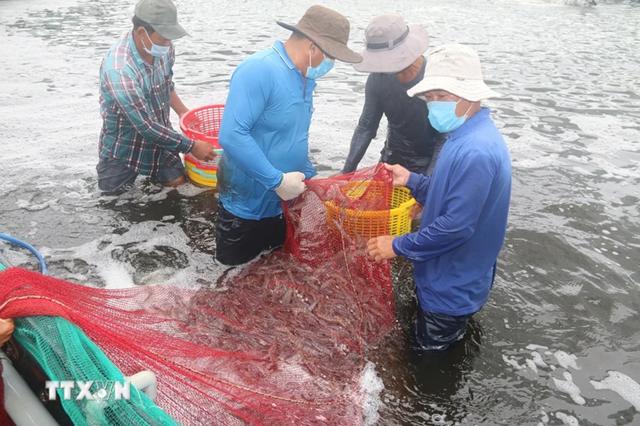
Shrimp farmers face challenges due to unpredictable weather conditions of rain and shine. (Photo: Hoang Nhi/VNA)
|
According to Mr. Ta Hoang Nhiem, Chairman of the Bac Lieu Province Shrimp Association, the rise in shrimp prices is a positive sign for farmers, and he hopes that the market will continue to be favorable towards the end of the year due to increasing demand.
However, unfortunately, farmers do not have much shrimp left to sell. Many households, fearing losses, have suspended their operations or engaged in minimal farming; others have opted to sell smaller shrimp to minimize potential losses.
Currently, the market price for raw material shrimp is as follows: 20 shrimps/kg fetch VND 195,000/kg; 40 shrimps/kg are purchased at VND 144,000/kg, and 100 shrimps/kg are bought at VND 95,000/kg. These prices reflect an average increase of VND 6,000-8,000/kg compared to the previous month.
Mr. Tran Van Mung, a farmer from Vinh Hau A commune in Hoa Binh district, shared his experience: “Since the beginning of the 2024 crop, shrimp prices have consistently dropped, and diseases have been rampant. Meanwhile, the prices of feed, probiotics, and equipment for shrimp production have continuously increased, creating challenges for shrimp farmers. I just hope that the prices will rise and stabilize towards the Lunar New Year so that shrimp farmers can end the 2024 season with a joyful note of good harvest and profitable prices.”
In the early months of 2024, unfavorable weather conditions caused slow growth and digestive issues in farmed shrimp. Many farmers suffered losses just a month after releasing their shrimp fry.
In addition to production challenges, farmers also faced high input costs for aquaculture, requiring significant capital investment.
Moreover, shrimp prices have been relatively low in the past. The combination of high risks, high production costs, and low shrimp prices has made many farmers hesitant to invest. They have opted to farm minimally and are waiting for better shrimp prices before resuming full-scale production.
Mr. Hua Van Quoc, from Vinh Thinh commune in Hoa Binh district, shared that due to unpredictable market prices and constantly changing weather, shrimp farming has become challenging, and many farmers have not made profits in recent crops.
Farmers are calling for attention from authorities to address their concerns. They hope for canal dredging to ensure clean and safe water for farming and stable feed prices to facilitate their operations. “We hope that the year-end price increase will bring cheer to farmers,” said one farmer.
Mr. Ho Thanh Tuan, Head of the Agriculture and Rural Development Office of Dong Hai district in Bac Lieu province, stated that they have provided guidance to shrimp farmers on protective measures during prolonged heavy rains caused by storms and tropical depressions in the last months of the year.
Specifically, during heavy rains, farmers should proactively reinforce and raise their embankments, maintain a water level of about 50 cm in their ponds, spread lime around the embankments, and apply lime in the ponds to stabilize pH and alkalinity. They should also reduce shrimp feed intake…
Additionally, farmers need to supplement minerals for the shrimp and increase the use of fans to minimize water stratification. Every 5-7 days, they must use microbial products to treat the water and pond bottoms as instructed to maintain a healthy environment for the shrimp.
According to Mr. Nguyen Trung Hieu, Deputy Director of the Bac Lieu Province Department of Agriculture and Rural Development, Bac Lieu is one of the six key shrimp-farming provinces in Vietnam and plays a significant role in various stages of the “shrimp supply chain” in the Mekong Delta and the country.
Bac Lieu ranks second in the country in terms of shrimp farming area and production volume. It also has a significant shrimp breeding scale, producing 34-35 billion shrimp fry per year, accounting for 50% of the Mekong Delta’s fry production and 30% of the national market share. The province boasts diverse shrimp farming models and is centrally located in the cluster for shrimp production, processing, export, and consumption.
Despite these achievements, shrimp farming faces challenges, including climate change impacts such as drought, saltwater intrusion, extreme heat, and localized heavy rains, which pose environmental and disease risks. There are also limitations in farmers’ access to scientific and technical advancements, with many relying primarily on traditional farming experiences. While cooperative models and linkages between farmers and businesses have been initiated, there are still gaps in investment approaches and product linkages, hindering sustainable development. As a result, economic efficiency has been modest and has not matched the province’s potential and advantages…
In 2023, the aquaculture area in Bac Lieu province exceeded 136,000 hectares, of which shrimp farming accounted for nearly 133,000 hectares. The estimated export volume of aquatic products reached over 96,000 tons, with an export turnover of over USD 1 billion.
To overcome these challenges, Bac Lieu province has outlined key tasks to ensure that shrimp remains a pillar of the local economy. These include intensifying information dissemination and promoting high-tech shrimp farming models to encourage enterprises and eligible households to transition from traditional intensive shrimp farming to high-tech applications.
The province aims to establish Cooperatives and High-tech Shrimp Farming Cooperatives, with companies and specialized agencies providing guidance to farmers on suitable farming models, consulting on farming processes, and facilitating connections with commercial banks. This will enable farmers to access capital and preferential interest rate policies to participate in high-tech shrimp farming models…
Chanh Da



